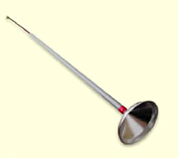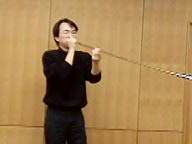The Structure of the Trombone
[Experiment] Let's make a straight trombone
Extend the slide and the tubing would be nearly 4 m long!
If you straightened the entire tubing of a typical tenor trombone, it would end up being 270 cm from mouthpiece to the end of the bell. Extending the slide would bring this to around 380 cm. Now, let's make a straight trombone and see what kind of sound it produces.
Experiment steps
-
1.Prepare a thick PVC tube (length of 1.5 m) and a slightly thinner tube (length of 2.7 m).

2.Attach a funnel to the end of the thick tube. (This will serve as the bell).
3.Wrap the end of the thin tube with double-sided tape, then wrap that with kite string. (This will serve as the stocking).

4.Attach the mouthpiece to the side opposite the side wrapped in kite string.

5.Insert the thin tube into the thick tube.

Straight trombone made from PVC
Results of the experiment
Sound when the slide is extended
Sound when the slide is contracted
The musical scale can be played!
These songs can be played!

The instrument sure looks strange, but it is surprisingly capable of playing music. Interestingly, the person blowing into the instrument can't hear the sound well at all. This experiment makes you realize that it is the bell from which sound is produced, because there are no holes for the sound to escape from before it reaches the bell. When the person blowing into the instrument speaks his voice travels through the tube and can be heard from the bell.
When the person moving the slide and the person blowing timed it just right, they were able to play the musical scale. If they keep practicing they could probably put on a performance!Brass straight trombone experiment
Let's make another straight trombone. This time, we'll make it out of brass (just like a real instrument) instead of PVC.
Results of the experiment
Sound when the slide is extended
Sound when the slide is contracted
The musical scale can be played!
These songs can be played!

Moving the slide on the soft PVC tube was quite difficult, but doing so on the brass instrument was very smooth. It also produces a much brighter and more beautiful timbre than the PVC tube.
We can guess that the reason why the intervals between sounds produced by the PVC tube trombone sounded sort of like minor keys without completely reaching the next note was that the tube was completely straight. In an actual instrument, the tube grows slightly thicker from the mouthpiece to the end of the bell (excluding the slide portion). This makes it easier to stay on pitch and produces a bright timbre. If you were to make the PVC tube trombone gradually thicker toward the bell, it would likely be easier to stay on pitch when playing it, also.Musical Instrument Guide:Trombone Contents
Structure
How to Play
How the Instrument is Made
Choosing an Instrument
Care and Maintenance
Trivia
- God is in the trombone
- The trombone was a bit of a problem for cavalries...
- A trombone that would scare even a snake!
- Two instruments, both tenor, but quite different!
- A trombone player walks into pawnshop...
- You can trill just by moving your mouth
- It is possible to increase the pitch even as you extend the slide
- Famous pieces from trombone concertos
- Orchestra pieces in which the trombone plays an important role
- The Yamaha quartet
- For trombones, why does sheet music notation differ from the fundamental tone of the instrument?
- A bass trombone-with an F attachment only
